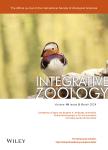Estimating abundance and density of Amur tigers along the Sino- Russian border
沿着中国俄语的边阶估计 Amur 老虎的丰富和密度作者机构:State Key Laboratory of Earth Surface Processes and Resource EcologyMinistry of Education Key Laboratory for Biodiversity Science and Engineeringand College of Life SciencesBeijing Normal UniversityBeijingChina Wildlife Biology ProgramDepartment of Ecosystem and Conservation SciencesCollege of Forestry and ConservationUniversity of MontanaMissoulaMontanaUSA Wildlife Conservation SocietyBronxNew YorkUSA Department of EcologyFar Eastern Federal UniversityAyaksRusski IslandVladivostokRussia EvolutionEcology and Organismal Biology ProgramDepartment of BiologyUniversity of CaliforniaRiversideCaliforniaUSA PantheraNew YorkNYUSA
出 版 物:《Integrative Zoology》 (整合动物学(英文版))
年 卷 期:2016年第11卷第4期
页 面:322-332页
核心收录:
学科分类:0710[理学-生物学] 07[理学] 071002[理学-动物学]
基 金:supported by grants from the Natural Science Foundation of China(31270567,31210103911,31421063,31200410 and 31470566) the National Scientific and Technical Foundation Project of China(2012FY112000)
主 题:Amur tiger camera traps density individual identification spatial capture-recapture
摘 要:As an apex predator the Amur tiger(Panthera tigris altaica)could play a pivotal role in maintaining the integrity of forest ecosystems in Northeast *** to habitat loss and harvest over the past century,tigers rapidly declined in China and are now restricted to the Russian Far East and bordering habitat in nearby *** facilitate restoration of the tiger in its historical range,reliable estimates of population size are essential to assess effectiveness of conservation *** we used camera trap data collected in Hunchun National Nature Reserve from April to June 2013 and 2014 to estimate tiger density and abundance using both maximum likelihood and Bayesian spatially explicit capture-recapture(SECR)methods.A minimum of 8 individuals were detected in both sample periods and the documentation of marking behavior and reproduction suggests the presence of a resident *** Bayesian SECR modeling within the 11400 km2 state space,density estimates were 0.33 and 0.40 individuals/100 km^(2) in 2013 and 2014,respectively,corresponding to an estimated abundance of 38 and 45 animals for this transboundary Sino-Russian *** a maximum likelihood framework,we estimated densities of 0.30 and 0.24 individuals/100 km^(2) corresponding to abundances of 34 and 27,in 2013 and 2014,*** density estimates are comparable to other published estimates for resident Amur tiger populations in the Russian Far *** study reveals promising signs of tiger recovery in Northeast China,and demonstrates the importance of connectivity between the Russian and Chinese populations for recovering tigers in Northeast China.



